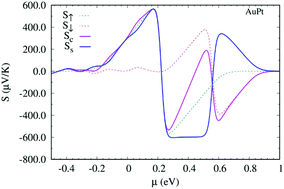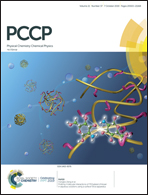Alloying-induced spin Seebeck effect and spin figure of merit in Pt-based bimetallic atomic wires of noble metals†
Abstract
We have investigated using first principles the occurrence and tunability of the spin Seebeck effect in Pt-based bimetallic wires of noble metals (viz. XPt, X = Cu, Ag, and Au) modelled in linear, ladder, and double zigzag (DZZ) topologies. The spin figure of merit ZsT and its charge counterpart ZcT are calculated by considering both electronic and phononic contributions to the thermal conductance. For this endeavour, we have employed the Landauer–Büttiker approach, with the requisite electron τel(E) and phonon τph(E) transmission functions obtained using the non-equilibrium Green's function approach, based on density functional theory and the general utility lattice program, respectively. We find that alloying and/or topological tailoring bring in quantitative as well as qualitative changes in the transport properties. Unlike the pristine wires, τel(E) now depends (except for the CuPt wire in the ladder topology) markedly on spin, thus resulting in an unequal current in the two spin channels and hence a non-zero spin Seebeck coefficient Ss. Remarkably, the AgPt wire in the linear topology and all wires in the DZZ1 and DZZ3 configurations of the DZZ topology exhibit half-metallic conduction, with a sizable gap in the density of ↑-spin states at the Fermi level. Alloying also introduces energy gap(s) in the phonon density of states. Consequently, we find a significant reduction in the electronic and phononic thermal conductance. Interestingly, Ss is of the same order as its charge counterpart Sc, and both can be tuned via the topology and chemical potential μ of the electrodes. This together with the reduced thermal conductance results in a significantly high room-temperature ZcT (∼33) and ZsT (∼25) at μ ∼ 0.24 eV in the AgPt wire in the DZZ3 topology, with about a ten-fold increase in ZcT as compared to the pristine wires. Furthermore, there exists a characteristic μ in some bimetallic wires for which Sc approaches zero, but Ss remains quite appreciable. This result arises due to the emergence of bipolar thermal conduction, which under criticality makes S↑ + S↓ = 0. Importantly, such a situation may be exploited to generate a pure thermal spin voltage. Our results can be explicated on the basis of changes in the electronic band structure and phononic spectra due to alloying and topological effects.



 Please wait while we load your content...
Please wait while we load your content...